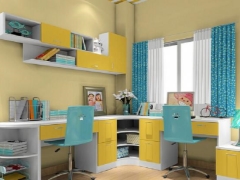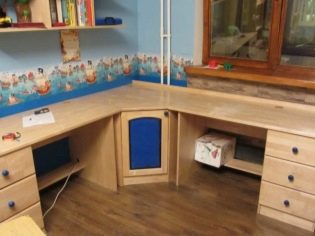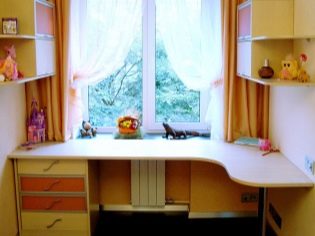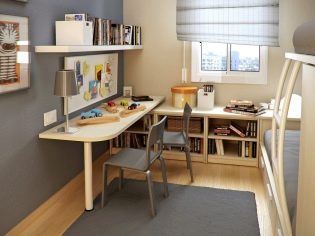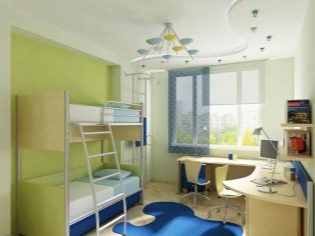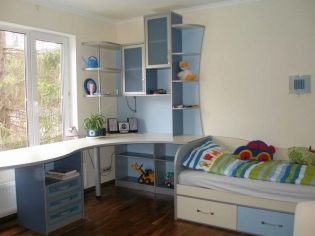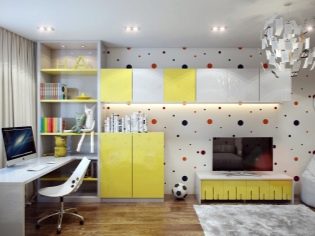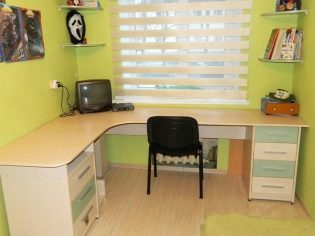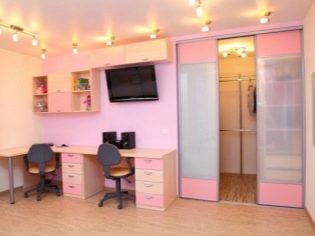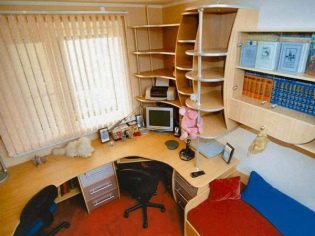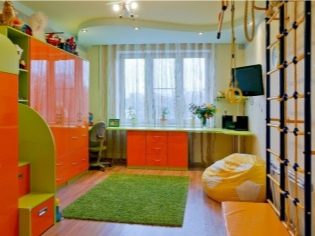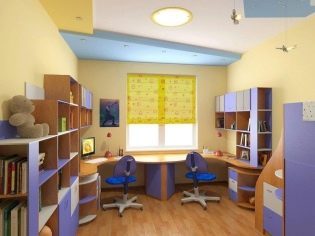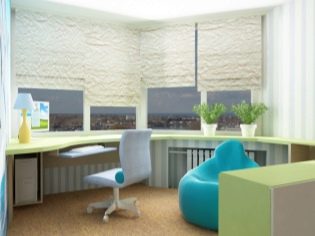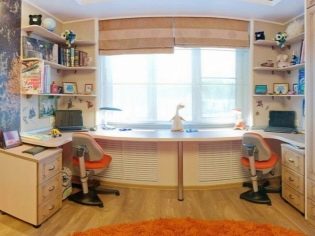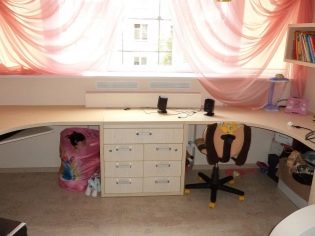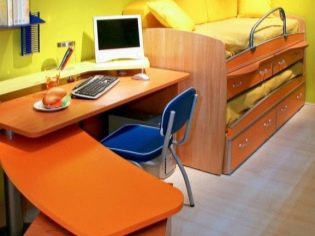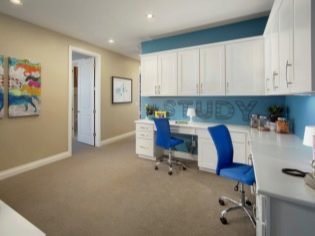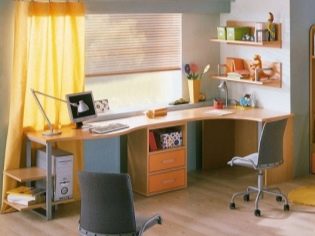Written corner table for two children
Corners are traditionally considered to be the most difficult part of the room in terms of furnishing, however, in small children's rooms, and even if there are two children in the family, not a single centimeter can be neglected.
Even a relatively small free space in corner It can be practically applied to create a convenient working area for two students at once.
Benefits
For two children in a small children's corner desk can surely be called the most ergonomic solution due to a variety of reasons. Here are the most basic among them:
- Unlike a similar direct table, the angular design turns out to be quite compact, since even a space of one and a half meters and a half is enough to create a full-fledged working area. A direct design with similar functionality would require up to two meters in length and at least a meter wide than it would cover a huge part of the room.
- The corner model is placed in a corner - a place where, for example, a bed does not fit. At the same time, such furniture is distinguished by a relatively small height, which allows it to stand right by the window, while the cabinet, it turns out, would not have gotten into it.
- Thanks to the combined design, mutual use of shelves and drawers by two children is permissible, which has a positive effect on the amount of space occupied compared to two separate tables.
Normal or computer?
Children's table, in its essence, can be one of two main types - either written or computer. Each of these options has its own advantages.
Desk
An ordinary desk is either a classical desk without any additions at all, or a tabletop supplemented with drawers for storing textbooks, notebooks, and other things necessary for schoolchildren. For the convenience of simultaneous learning of two children at once, the boxes should be located in the middle - then the same ease of access is provided, and they do not interfere with sitting.
Such a solution is in demand due to the fact that there is nothing superfluous here, that is, even the smallest tabletop provides high convenience of doing lessons. If the model has no boxes at all, or they are not large enough, you can always purchase additional wall shelves and hang them above the table.
The absence of fixed add-ons is a positive thing, for the reason that the table can be put in one side even directly to the window.
Computer desk
A computer desk, on the contrary, is distinguished by the maximum number of shelves and add-ins. The angular model of it is perhaps more practical than similar lines, because the place for a monitor is usually located in the very corner where children are not too comfortable to get, almost all the superstructures are often located there.
The design often provides a special elevation for the monitor, which improves its visibility, minimizes the likelihood of inaccurate damage to the screen with a pen, and is also a natural separator between the functional zones of each of the children.
Due to the large capacity of the table itself, it allows you to refuse additional shelves, but it is difficult to install it in the corner next to the window.
The organization of the combined work area
Although the phrase “corner table” seems very clear and describes a very standard design, the inventive designers of modern times have come up with several completely different curly figures. decisions involving different arrangement of children when working at such a table.
Classic option – This is when the two parts of the corner table, 90 degrees to each other, are exactly the same size. At such a table, two children sit, touching their shoulders, but they are deployed in different directions. A computer, as well as storage boxes and shelves at the same time share their functional zones and unite them, since they are common, and they are easily accessible for both kids.
As an alternative, parents can choose two corner tables at once, placing them in opposite corners of the room - then each child will have their own, independent work area, and one of the wings of each table, respectively, can be significantly shortened.
Often, an angular table of this type unfolds the other way around - with a sharp angle to the center of the room in order to visually separate the playing area from the working area.
In rooms of relatively small width, they are highly popular. Models shaped like the letter C. As children grow, experts recommend choosing models with adjustable table height, however, the corner structures rarely allow this option. In fact, these are the same two corner tables located in adjacent corners, however, united by a common body. At such a table, children sit with their backs to each other - this allows each of them not to be distracted by the second. Among other things, such tables are also very good in that they ensure that natural light from the window is evenly transmitted to the working areas of each of the children.
There is also a variation of such a two-corner table, in which parts directed into the interior of the room are trimmed - then each of the corners is a personal computer table with add-ins and shelves for one of the kids, and the table-top connecting two corners is a wide common desk.
Dimensions
Corner tables are often chosen as a necessity in conditions of limited space, and yet for the convenience of the kids, they must meet certain minimum sizes. It is difficult to select some common dimensions for the entire table, since they come in different forms, because it is much easier to build on the recommended size of the workplace for each of the children.
The normal depth of the table is about 50-60 cm - this is enough for placement in two rows of a textbook and a notebook. The required width of the workplace is highly dependent on the age of the child and can vary from the same 50-60 cm for a first grader to 80-90 cm for children of senior school age.
The described parameters relate precisely to the place for writing, so if a computer should also fit on the table, then a separate zone should be provided for it.
The most difficult thing when choosing a corner table for two children - This is a selection of models on the height of the tabletop. The optimal height of the table is the main factor influencing the formation of correct posture - it is usually assumed that the tabletop should be placed at the level of the elbows of a sitting child, or even slightly lower. As children grow, Experts recommend choosing models with adjustable table heightHowever, angular designs rarely allow this option. In addition, if the children are of the same age, then the problem does not look so serious, but if they have a significant difference in age and height, the parents will have to work hard to find a model that allows separate height adjustment for each workplace.
However, to find a suitable model of this type in the finished form is very difficult - if they are, it is mainly produced to order. The problem can be solved with the help of chairs, adjustable in height, separately adjusting them to the current height of each of the kids.
How to choose the right table and chair for a childSee the next video.
